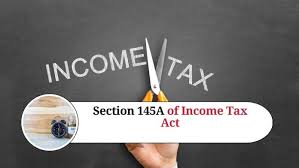Section 145 of the Income Tax Act deals with the processes and standards of accounting for business owners and professionals. It allows an assessee to follow one of the following accounting systems — cash system or mercantile system as per ICDS (Income Computation and Disclosure Standards). On April 1 1999, the Government of India introduced Section 145A of the Income Tax Act to bring in a new accounting method for some instances.

What is Section 145A of the Income Tax Act?
The Finance Act, 2018 replaced earlier sections with Section 145A and Section 145B to bring certainty regarding the applications of ICDS. It substituted the old Section 145A from April 1, 2017.
Section 145A determines your taxable income under ‘Profits and gains from business and profession’ and ‘Income from other sources‘. It states that regardless of the provisions of Section 145, valuation of purchase or sale of inventory and goods under income from business/profession will be determined at:
- A lower cost or NRV (net realisable value), which is calculated as per computation and disclosure rules of Section 145(2)
- The valuation of goods/services and inventory would be further adjusted to include any taxes, cess or duty (This consists of any fees paid/incurred to bring goods/services to their location as of the day of valuation.)
- Valuation of listed or unlisted securities not quoted on recognised stock exchanges is done at the actual costs as per ICDS u/s 145(2).
- According to Section 145A of the Income Tax Act, you need to value other securities at a lower actual cost or NRV in accordance with ICDS.
- Scheduled commercial banks and public financial institutions need to disclose their inventories in accordance with ICDS and RBI guidelines.
Income Computation Standards as per ICDS
As per Section 145A of the Income Tax Act, assesses need to follow the Income Computation and Disclosure Standards for valuation of inventory or securities. The Central Government, through its powers u/s 145(2), notifies the applicability of ICDS.
ICDS is applicable to all taxpayers who have taxable income from businesses, professions or other sources. They are applicable for taxpayers who follow the mercantile system of accounting and need their accounts audited u/s 44AB. Non-corporate taxpayers computing income under the presumptive taxation scheme must also follow it.
This accounting standard states that taxpayers have to disclose accounting policies as well as the total amount of inventories in financial statements. Moreover, they have to value inventories at actual cost or NRV, whichever is lower.
Understanding the Valuation of Inventories under the IT Act
Under the Income Tax Act, assessees need to maintain books of accounts. Section 145 of the IT Act states the accounting standards which they need to follow for income from business, profession or other sources. There are two modes of accounting you can follow in recording your income, assets, and liabilities:
- Cash method: In this, you record the transactions in books of accounts for inflow or outflow of cash. It is a simple method of accounting but has low accuracy and is not recognised by the Companies Act.
- Mercantile method: In this method, you record transactions when you accrue income or expenses. It does not depend on whether you have received cash on the day of the transaction. This method though more complex is highly accurate and recognised by the Companies Act.
What Is Net Realisation Value and Actual Cost of Inventories/Securities?
Net Realisation Value (NRV) is the estimated selling price of an asset upon the realisation of its sale. The estimated costs of completion and expenses necessary for this sale are deducted from the selling price.
As per Section 145A of the Income Tax Act, assessees must value inventories and listed securities at NRV or actual price, whichever is lower. Cost of inventories includes expenses for purchases, services, conversion and other costs to bring it to current conditions. The actual cost of inventories also consists of the purchase price, including duties, taxes, freight charges, and other expenses directly contributing to the acquisition.
Note that the Interest and borrowing costs are not included unless for recognition of interest. Furthermore, trade discounts and rebates are reduced to determine the cost of purchase.
The following costs are included in the actual cost of securities:
- Its purchase price
- Acquisition costs, including tax, duty, cess, brokerage, and other fees
- When you acquire security in exchange for another security, its fair value price
- The fair value price of security acquired by exchange of another asset
FAQs
What does Section 145A cover?
Section 145A provides the method to be followed by taxpayers in determining the value of inventories (goods that a business holds for sale or use) while computing income. This section ensures that indirect taxes, such as excise duty, VAT, and sales tax, are included in the cost of inventory.
Key Provisions of Section 145A?
Valuation of Inventory:
- Section 145A specifies that the value of inventory should include excise duty, VAT, and other taxes paid on goods purchased or produced, to the extent applicable.
- When calculating the closing stock, the amount of taxes (such as excise duty, sales tax, VAT) paid on purchased goods should be added to the cost of goods.
- For manufactured goods, taxes such as excise duty should be included in the value of the finished goods inventory.
Adjustment of Tax Credits:
- The section also requires that when taxes (such as excise duty or VAT) are charged or recovered, they should be adjusted in the books of account.
- If excise duty or VAT is paid or recoverable on inventory, it must be treated as part of the value of inventory at year-end. Similarly, any tax credit received or receivable should also be accounted for.